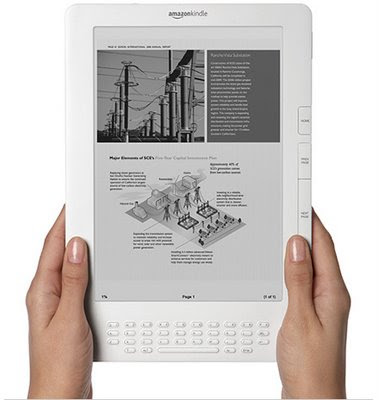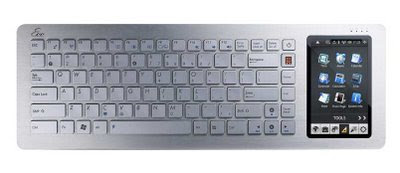Friday, June 12, 2009
My DIGIT Webinar
Thursday, June 11, 2009
Google and Bing : Bade miyaaan Chotey Miyaan
Sunday, June 07, 2009
PAPER BOOKS CONVERGE TO E-BOOKS : KINDLE DX
2. Slowly over a period of time, now 10 years, the thing doesn't look inconceivable. To add to the various options available today in form of e-mails, web sites, mobiles etc.....the latest IN thing is KINDLE DX from Amazon. The gadget is shown in the pic inset.

3. Recently read about the same in the June issue of Digit. It also mentioned about how the biggest library of the world ie British Library is putting in lots of effort in digitizing books available presently on its shelves. It has put up four giant scanners, working for last 2 years with the help of a 21 MP camera clicking all the way while a robotic arm turns them.

4. The configuration of this KINDLE Dx is as follows :
- Slim: Just over 1/3 of an inch, as thin as most magazines
- Carry Your Library: Holds up to 3,500 books, periodicals, and documents
- Beautiful Large Display: 9.7" diagonal e-ink screen reads like real paper; boasts 16 shades of gray for clear text and sharp images
- Auto-Rotating Screen: Display auto-rotates from portrait to landscape as you turn the device so you can view full-width maps, graphs, tables, and Web pages
- Built-In PDF Reader: Native PDF support allows you to carry and read all of your personal and professional documents on the go
- Wireless: 3G wireless lets you download books right from your Kindle DX, anytime, anywhere; no monthly fees, no annual contracts, and no hunting for Wi-Fi hotspots
- Books In Under 60 Seconds: You get free wireless delivery of books in less than 60 seconds; no PC required
- Long Battery Life: Read for days without recharging
- Read-to-Me: With the text-to-speech feature, Kindle DX can read newspapers, magazines, blogs, and books out loud to you, unless the book's rights holder made the feature unavailable.
Saturday, June 06, 2009
Buy a Keyboard : Get a Computer



Friday, June 05, 2009
THE 'G' Family : 0G to 4G
2. 2G (or 2-G) is short for second-generation wireless telephone technology and these were commercially launched on the GSM standard in Finland in early 90s. Three elemental benefits of 2G networks were :
(a) Phone conversations were digitally encrypted.
(b) More efficient on the spectrum allowing for far greater mobile phone penetration levels
(c) 2G introduced data services for mobile, starting with SMS text messages.
The main 2G standards are:
- GSM (TDMA-based)
- IS-95 aka cdmaOne , (CDMA-based, commonly referred as simply CDMA in the US
- PDC (TDMA-based), used exclusively in Japan
- iDEN (TDMA-based), proprietary network used by Nextel in the United States and Telus Mobility in Canada
- IS-136 aka D-AMPS, (TDMA-based, commonly referred as simply TDMA in the US

3. 2.5G is considered to be a way between 2G & 3G cellular wireless technologies. The term "second and a half generation" is used to describe 2G-systems that have implemented a packet switched domain (Packet switching is a network communications method that groups all transmitted data, irrespective of content, type, or structure into suitably-sized blocks, called packets.) in addition to the circuit switched domain(a circuit switching network is one that establishes a circuit between nodes and terminals before the users may communicate, as if the nodes were physically connected with an electrical circuit.) This got famously known as GPRS and was able to provide data rates from 56 kbit/s up to 114 kbit/s.
4. 2.75G actually meant to refer the EDGE technology ie Enhanced Data rates for GSM Evolution, as the name suggests allows improved data transmission rates as an extension on top of standard GSM. EDGE can carry data speeds up to 236.8 kbit/s. There is also something known as evolved EDGE which is a further extension over EDGE wherein Peak bit-rates of up to 1Mbit/s and typical bit-rates of 400kbit/s are supported.
5. 3G is the third generation of telecommunication hardware standards and general technology for mobile networking, superseding 2.75G. This would be able to provide even higher transmission rates that would range from a minimum speed of 2Mbit/s to a maximum of 14.4Mbit/s for stationary users, and 348 kbit/s in a moving vehicle.
6. 4G is the short term for fourth-generation wireless, the stage of broadband mobile communications that will supplant the third generation (3G). While neither standards bodies nor carriers have concretely defined or agreed upon what exactly 4G will be, it is expected that end-to-end IP and high-quality streaming video will be among 4G's distinguishing features. Fourth generation networks are likely to use a combination of WiMAX and WiFi.
7. I was curious to know about all the G’s and have written in brief of what I have understood very clearly and read from Wiki and other good sources.Thanks Wiki again!
Tuesday, June 02, 2009
GSM vs CDMA & Open Market Handset
2. So the first thing of interest to me was to know as to why in India, CDMA has not been such a huge success as in west.Why GSM has been given the lead in handsets. Why is it that a CDMA subscriber has a limited choice of handsets and a GSM subscriber has a variety to choose from? To be with stats, of the 376.12 million mobile subscriber base(ex INDIA only) only 97.77 million use CDMA network.(Pic Inset courtesy :

3. CDMA services were launched in the year 2002 in India with the sole intention of acquiring a sizeable subscriber base by allowing the customers to affordable devices with minimum features like color screen and FM Radio. In order to attain this aim,the OEMs then introduced handsets that could be used only with their networks. More distinctly I remember RELIANCE doing the brunt of the job. But that was in 2002.Over last seven years, the times have commuted, the customer’s desires have changed, the technology has changed, the psych of the intended customer has changed for better. He has become ready to shelve out some money for more features and why not? With the introduction of handsets like Nokia 5800,LG Cookie and Samsung Pixon, the customer is likely to be enticed!!!!!!!!!!!
4. Those customers who got into the CDMA tag over the years have had no problem with the services proffered, the price of the calls, all is OK except for the problem that they have to persist in with the same handset for so long as there is no choice in the CDMA segment. But not now……OEMs of the handsets have started coming up with new generation handsets which support both GSM and CDMA in one. The most common handset manufacturers that come first to mind include NOKIA,SAMSUNG,LG,VIRGIN,MOTOROLA and now more promising Indianised manufacturers include FLY,GEE PEE,X FONE,LEMON,MAGICON(I am certain u have heard none of them)
5. So the good thing about the CDMA subscribers is the introduction of OMH ie Open Market Handset started by the CDMA development group which is an international body comprising CDMA Operators, manufacturer’s and application providers. This body enables full boasted CDMA devices to be used in any OMH compliant operator network. Thus the Bandhan of constraining to one operator and OEM is no more rifer.
 https://orcid.org/0000-0002-9097-2246
https://orcid.org/0000-0002-9097-2246







